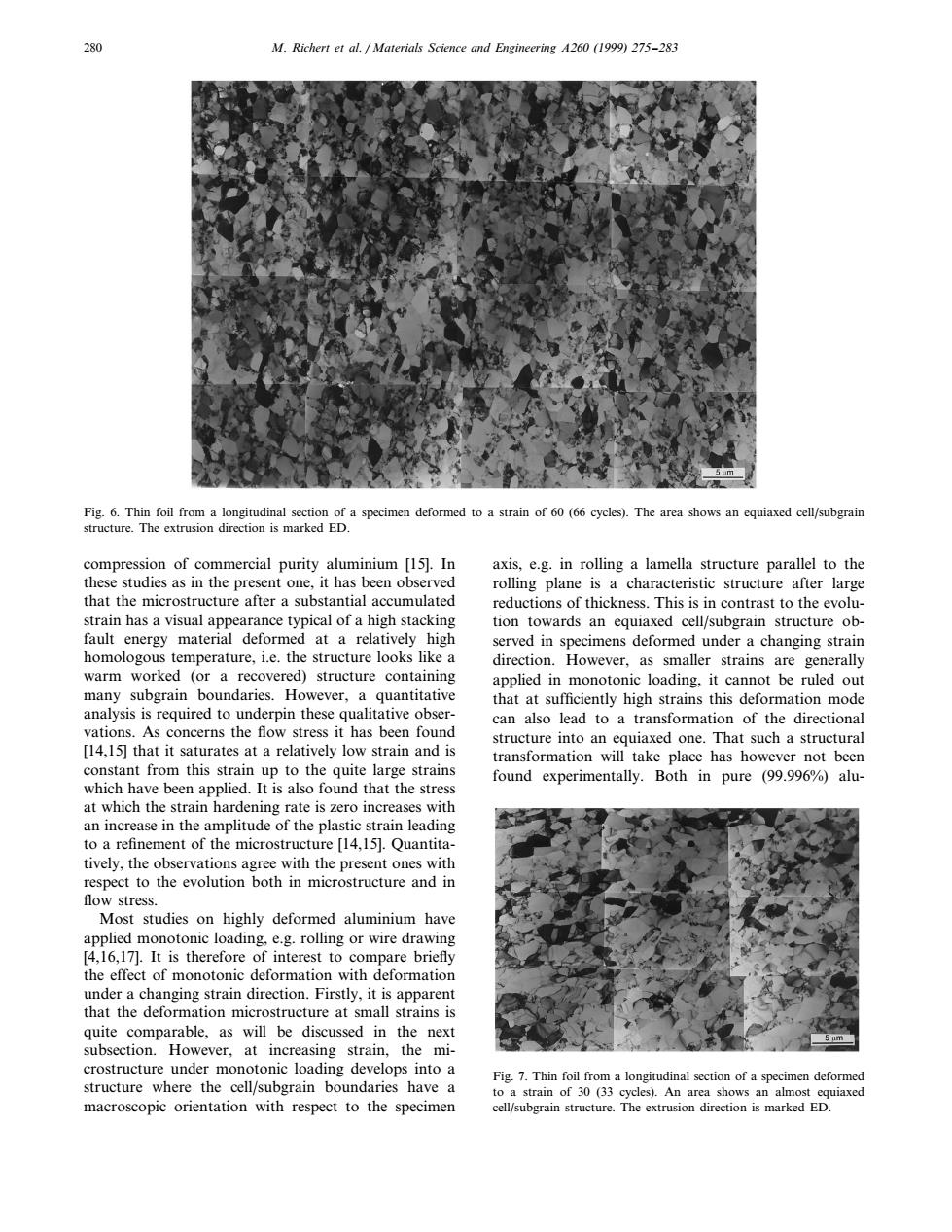正在加载图片...

280 M.Richert et al./Materials Science and Engineering A260(1999)275-283 Fig.6.Thin foil from a longitudinal section of a specimen deformed to a strain of 60(66 cycles).The area shows an equiaxed cell/subgrain structure.The extrusion direction is marked ED compression of commercial purity aluminium [15].In axis,e.g.in rolling a lamella structure parallel to the these studies as in the present one,it has been observed rolling plane is a characteristic structure after large that the microstructure after a substantial accumulated reductions of thickness.This is in contrast to the evolu- strain has a visual appearance typical of a high stacking tion towards an equiaxed cell/subgrain structure ob- fault energy material deformed at a relatively high served in specimens deformed under a changing strain homologous temperature,i.e.the structure looks like a direction.However,as smaller strains are generally warm worked (or a recovered)structure containing applied in monotonic loading,it cannot be ruled out many subgrain boundaries.However,a quantitative that at sufficiently high strains this deformation mode analysis is required to underpin these qualitative obser- can also lead to a transformation of the directional vations.As concerns the flow stress it has been found structure into an equiaxed one.That such a structural [14,15]that it saturates at a relatively low strain and is transformation will take place has however not been constant from this strain up to the quite large strains found experimentally.Both in pure (99.996%)alu- which have been applied.It is also found that the stress at which the strain hardening rate is zero increases with an increase in the amplitude of the plastic strain leading to a refinement of the microstructure [14,15].Quantita- tively,the observations agree with the present ones with respect to the evolution both in microstructure and in flow stress. Most studies on highly deformed aluminium have applied monotonic loading,e.g.rolling or wire drawing [4,16,17].It is therefore of interest to compare briefly the effect of monotonic deformation with deformation under a changing strain direction.Firstly,it is apparent that the deformation microstructure at small strains is quite comparable,as will be discussed in the next 5 um subsection.However,at increasing strain,the mi- crostructure under monotonic loading develops into a Fig.7.Thin foil from a longitudinal section of a specimen deformed structure where the cell/subgrain boundaries have a to a strain of 30 (33 cycles).An area shows an almost equiaxed macroscopic orientation with respect to the specimen cell/subgrain structure.The extrusion direction is marked ED.280 M. Richert et al. / Materials Science and Engineering A260 (1999) 275–283 Fig. 6. Thin foil from a longitudinal section of a specimen deformed to a strain of 60 (66 cycles). The area shows an equiaxed cell/subgrain structure. The extrusion direction is marked ED. compression of commercial purity aluminium [15]. In these studies as in the present one, it has been observed that the microstructure after a substantial accumulated strain has a visual appearance typical of a high stacking fault energy material deformed at a relatively high homologous temperature, i.e. the structure looks like a warm worked (or a recovered) structure containing many subgrain boundaries. However, a quantitative analysis is required to underpin these qualitative observations. As concerns the flow stress it has been found [14,15] that it saturates at a relatively low strain and is constant from this strain up to the quite large strains which have been applied. It is also found that the stress at which the strain hardening rate is zero increases with an increase in the amplitude of the plastic strain leading to a refinement of the microstructure [14,15]. Quantitatively, the observations agree with the present ones with respect to the evolution both in microstructure and in flow stress. Most studies on highly deformed aluminium have applied monotonic loading, e.g. rolling or wire drawing [4,16,17]. It is therefore of interest to compare briefly the effect of monotonic deformation with deformation under a changing strain direction. Firstly, it is apparent that the deformation microstructure at small strains is quite comparable, as will be discussed in the next subsection. However, at increasing strain, the microstructure under monotonic loading develops into a structure where the cell/subgrain boundaries have a macroscopic orientation with respect to the specimen axis, e.g. in rolling a lamella structure parallel to the rolling plane is a characteristic structure after large reductions of thickness. This is in contrast to the evolution towards an equiaxed cell/subgrain structure observed in specimens deformed under a changing strain direction. However, as smaller strains are generally applied in monotonic loading, it cannot be ruled out that at sufficiently high strains this deformation mode can also lead to a transformation of the directional structure into an equiaxed one. That such a structural transformation will take place has however not been found experimentally. Both in pure (99.996%) aluFig. 7. Thin foil from a longitudinal section of a specimen deformed to a strain of 30 (33 cycles). An area shows an almost equiaxed cell/subgrain structure. The extrusion direction is marked ED